Emerging soon from a wetland near you.
By: Jenna Kentel
Do you go into hibernation mode for the winter? Are you already searching for signs of spring? You are not alone! The turtles and I are also patiently waiting to bask in the summer sun once again.
My name is Jenna Kentel and I am a graduate student in Biology at Laurentian University. During the warmer months, you can find me in a pristine wetland complex on the eastern shores of Georgian Bay. For me, there is no better way to spend my summer than chest-deep in murky waters among the turtles. I bet you are wondering why I think this is a great way to spend my summer. It’s because turtles are an evolutionary wonder and are an essential part of our ecosystem, yet they are struggling to survive in a world altered by humans. I seek to apply myself to their conservation.
Fortunately, in 2021, I had the opportunity to work with the Georgian Bay Mnidoo Gamii Biosphere (GBB) and Shawanaga First Nation (SFN) on their Maamwi Anjiakiziwin initiative. This initiative is a collaborative effort between communities, organizations, municipalities, and individuals to protect multiple species and their environments. As a Master’s student from Laurentian University, I joined forces to help with the reptile and road ecology project. The goal of this project is to investigate the threats of roads to reptiles. Specifically, my research is focused on evaluating new strategies to help reduce the harmful effects of roads on turtle communities.
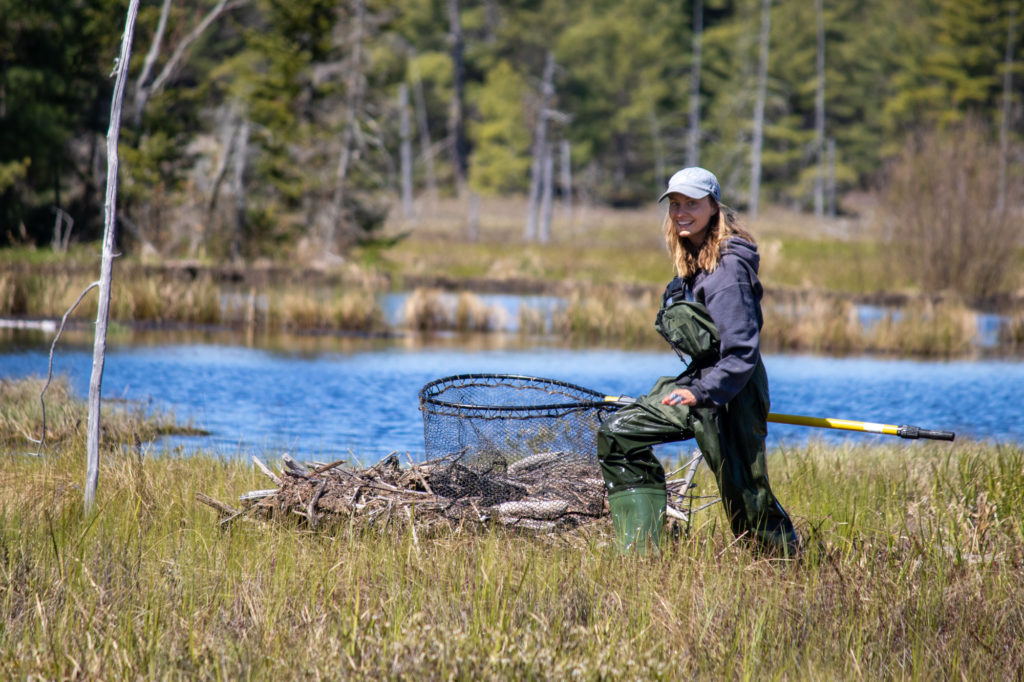
To evaluate if the strategy effectively reduces road threats, we first need to familiarize ourselves with the turtle community in our study area. To do this, we initiated a rigorous mark-recapture study to investigate the population demographics. This is where the fun begins! During the summer, we spent almost every day wading through wetlands to search for our shelly friends. However, a turtle can quickly go from basking on a log to disappearing deep into the wetland, making them tricky to catch. We have special techniques to help us catch these study turtles, including using juicy sardines.
Every new turtle found was given a permanent, unique identification code on their carapace (top shell). The ID code is notched into the outer edge of a turtle’s carapace using a triangular file. This allows us to identify individual turtles upon recapture. Health and growth measurements were also taken for each turtle as part of their annual ‘check-up’. Measurements such as weight, carapace length, and plastron length were taken so we can track turtles’ growth over time. After several years of data collection, we will be able to estimate the population size and structure of turtles in our study area. Knowing the population size will allow us to understand how the road and mitigation strategy affect the turtle community. zwonderful people involved in these capture efforts, including GBB and SFN staff, community volunteers, road works staff, friends, and family. After 78 days of trapping, we captured a total of 248 new turtles! We also had a total of 78 recaptured turtles. This means that we got to see some turtles over and over again as they gobbled up sardines and graced us with their presence.
Spending every day in the same wetland complex, we got to know individual turtles from the community very well – you could even say that we were on a first name basis. In this first annual edition of “Meet the Turtles”, I would like to introduce you to a few of our favourite turtles we met in 2021.
Bullet
There is always one that keeps you guessing. Bullet is that turtle. Early in the field season, on a wetland scouting mission, this handsome Blanding’s was our first turtle sighting of the season. Erica, a species at risk technician with SFN, and I happened to stumble upon Bullet as we were familiarizing ourselves with the wetlands. Bullet was on shore with his limbs and head tucked into his shell, looking inconspicuous. He almost went undetected but thankfully Erica discovered this tricky Blanding’s hiding in the vegetation. Bullet was named from the uniquely shaped hole on his carapace. On this day we were not equipped with the proper processing tools, so Bullet went unmeasured and unnotched. However, I am holding out hope that we will be reacquainted with Bullet in 2022 so that we can officially add him to the study.
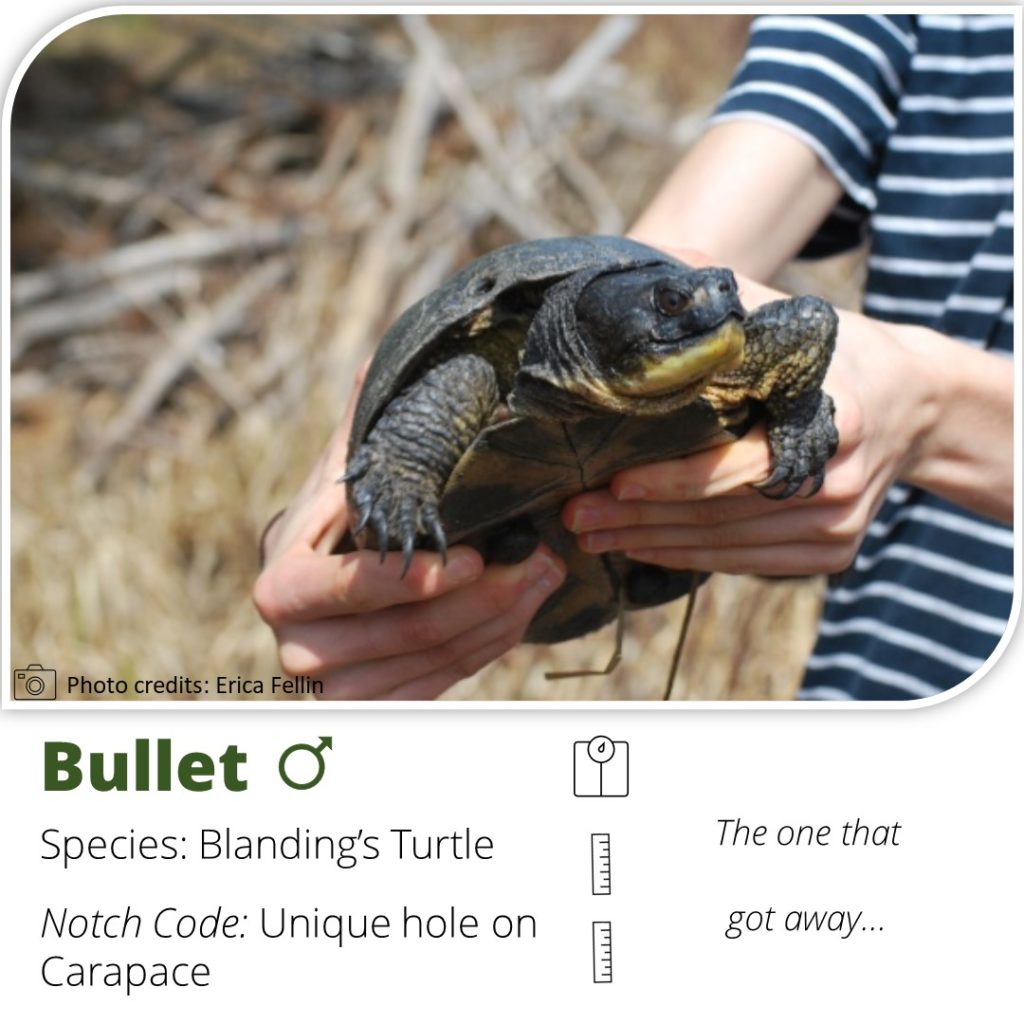
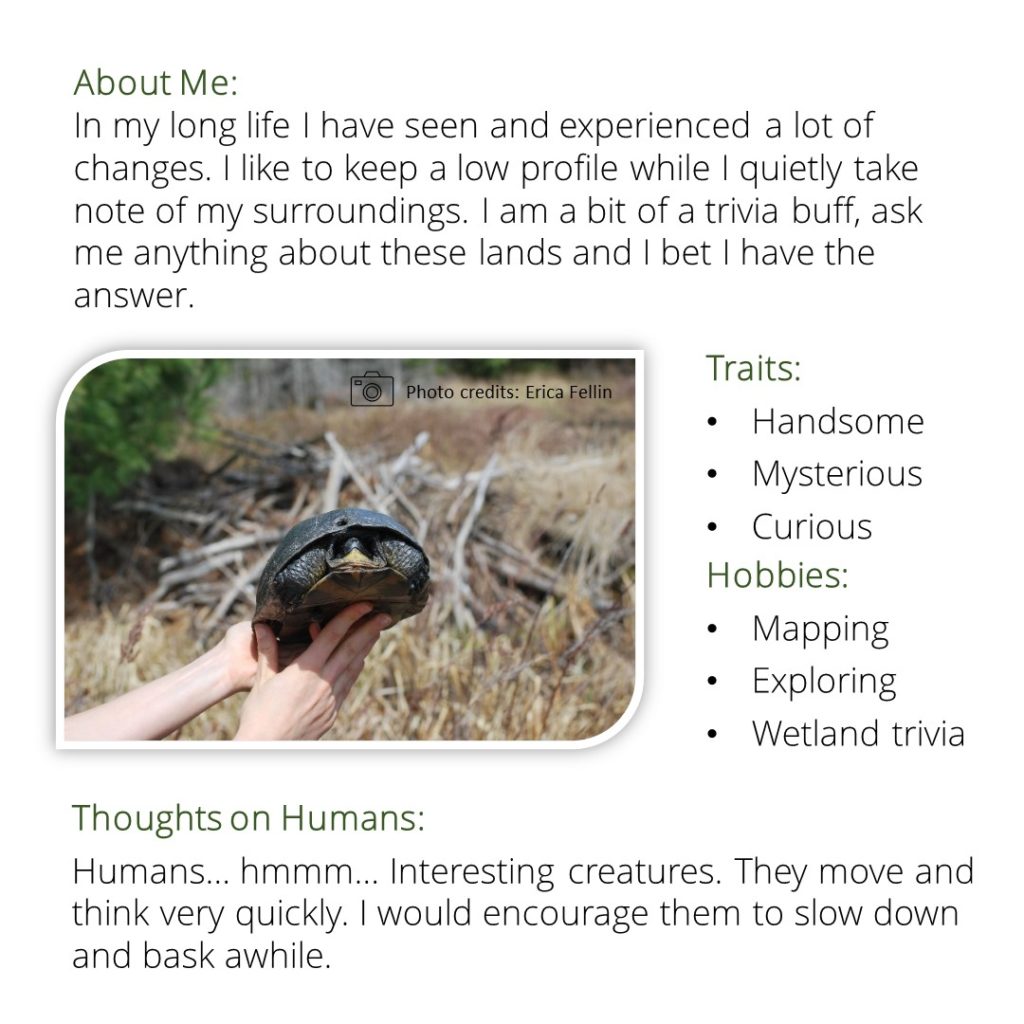
Truffula
Truffula holds an extra special place in my heart because she was the first turtle that was officially notched and measured as part of the study. I found her on a warm sunny day, and being my first turtle, I took my time taking her measurements. Throughout the entire process, Truffula was incredibly patient. I would like to think that if we met again, she would be just as sweet. However, her extra gentle nature was likely because she had recently emerged from overwintering and was just ‘warming up’ for the active season.
If you have read the Lorax by Dr. Suess, you may have already guessed where the name Truffula comes from. Truffula’s are the fluffy orange topped trees that need protecting from the people of Thneedville. Like the trees, Snapping Turtles are important to their biological communities but face many threats and need the help of humans to conserve their populations. Also, the orangish colour of this turtle reminded me of the Truffula treetops. The skin colour of snapping turtles can greatly vary from tan to brown or, like this snapper, a deep reddish orange colour that can occur in iron-rich environments.

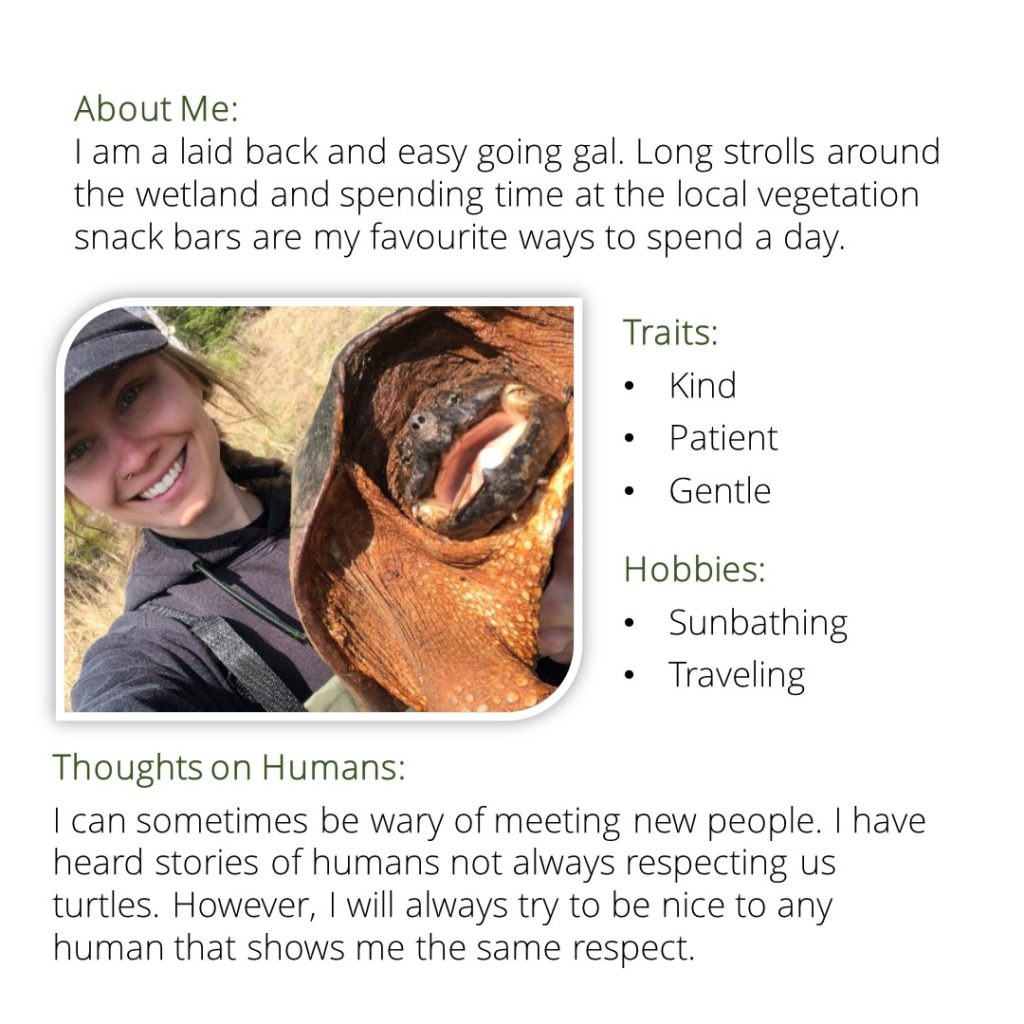
Peeves
Weighing in at 31 pounds, Peeves holds the record for being the heaviest turtle in the study. Not surprisingly, because of his love of sardines, he also holds the record for the most recaptures in 2021. Peeves was found in our hoop-nets a total of 8 times. He was often found in the net in the company of other Snapping Turtles or Painted Turtles. From the start, a unique relationship was established with Peeves. He was by far the most difficult to manage. Due to his unwavering love of sardines, he did not separate from the net easily. Although stubborn and difficult, his charm made him easy to love. Peeves knew what he liked, how to get it, and that he would always receive 5-star service from the hoop-net sardine pop-up restaurant. How could we not love and appreciate his determination?


Filch
This turtle rivals Peeves as the second heaviest turtle captured in the study. Weighing in at 30 pounds, this turtle knew how to throw his weight around the wetland and had an attitude to match. His big personality made him come across as very grumpy. Although he had a taste for sardines, finding himself attracted to the nets more than once, he was never pleased to see us. He is the kind of turtle that you know has seen a lot of changes during his long life. Can we really blame him for not wanting to be bothered? We tried to make our time with him very short and sweet, so he could keep on patrolling his wetland. Being so close in weight to Peeves, perhaps in 2022 he will take the lead!
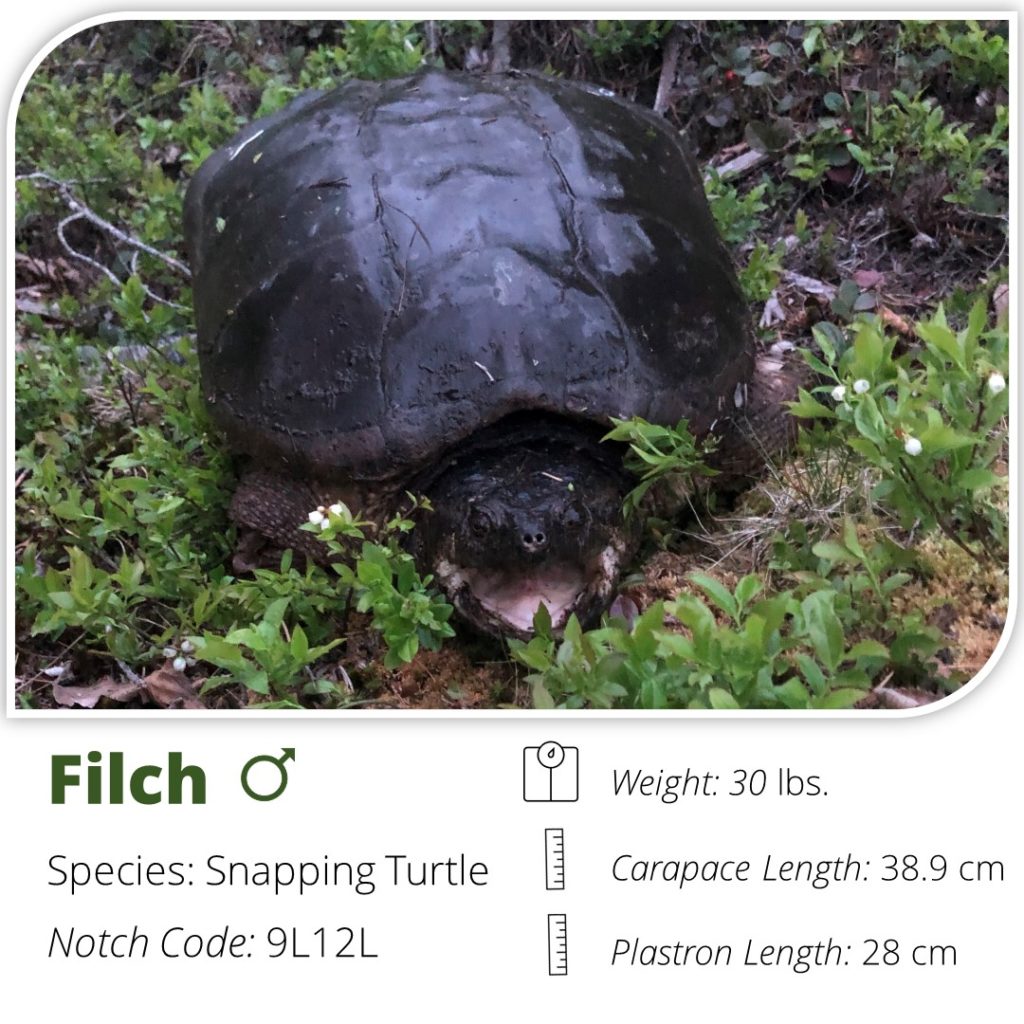
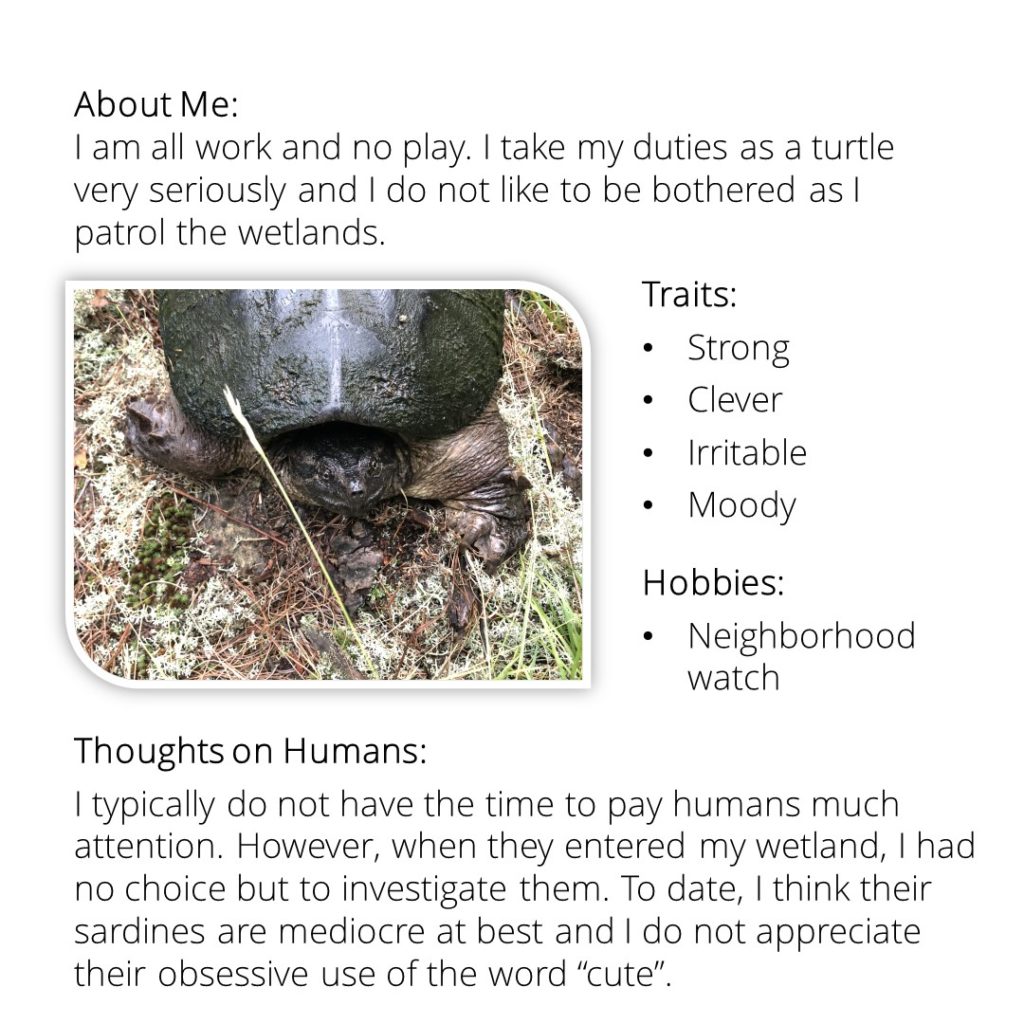
Buster
We were fortunate to have several volunteers join us in the field to learn about turtles and help check our traps. Some days we would sadly find ourselves unsuccessful in finding or capturing any turtles. During these times, it was easy to question why you were chest deep in a wetland being swarmed by bugs in the first place. However, those thoughts would quickly disappear in the sweet moment when you lift a trap out of the water and see a little turtle face staring up at you. This is how Buster came into the study. Found by one of our great volunteers, Buster was our lucky turtle that broke a long dry spell of turtle-less days. Experiencing moments like these can be a slippery slope into devoting your time to turtle conservation efforts.
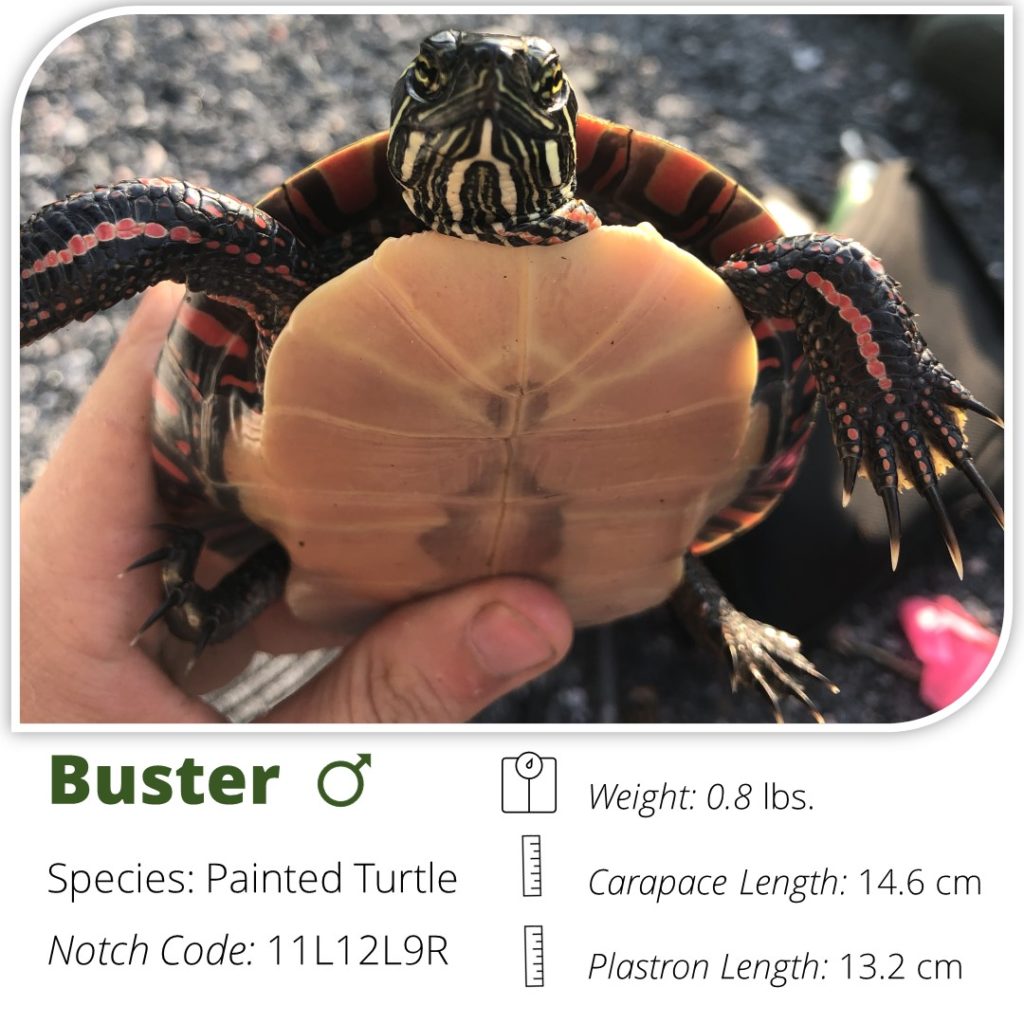
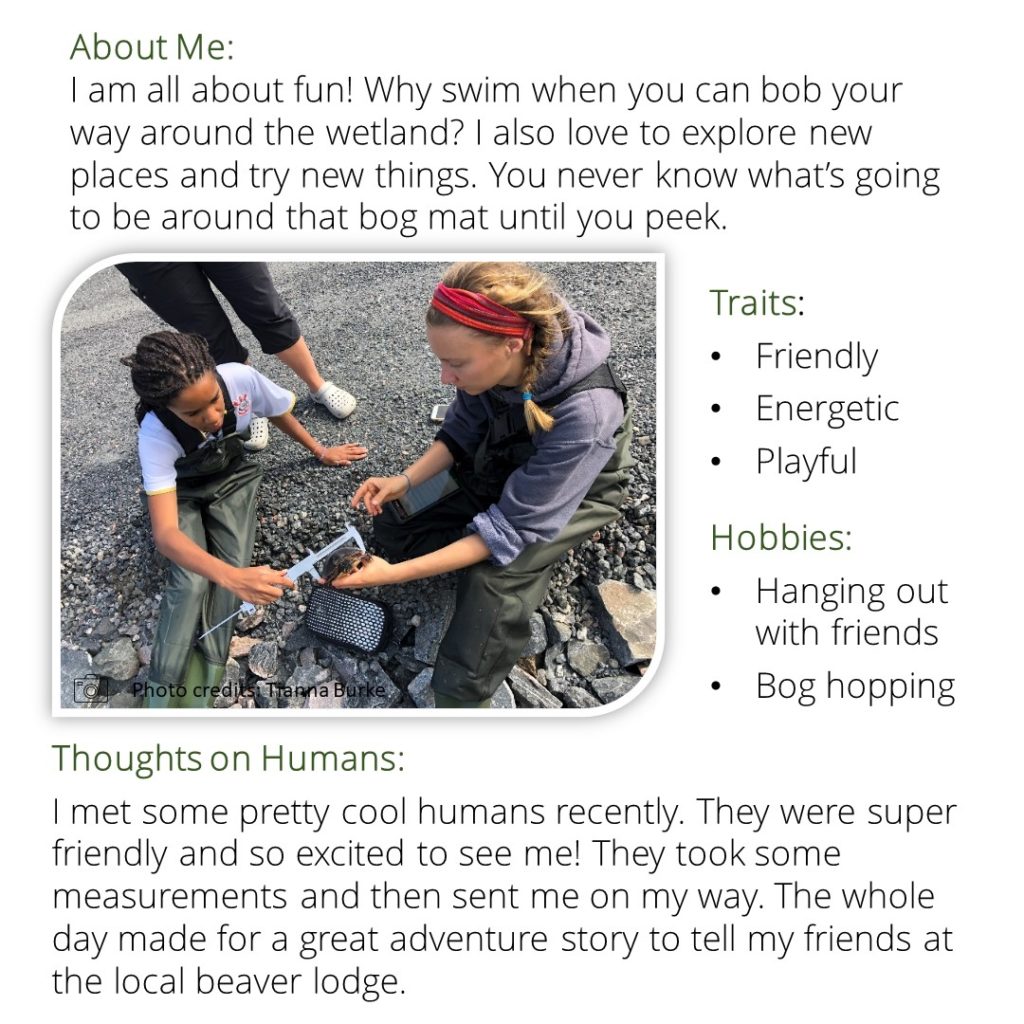
Harold
From May to early July, female turtles will often be found nesting on road shoulders. On our study road, this happened to coincide with road construction making it a busy time for the construction crew and the turtles! Luckily, we got to work with a great group of people from the local construction companies and the Township of the Archipelago who were keen to help us protect species found on the road. In particular, one of the construction workers, named Scott, shared our passion for turtle conservation and always helped us keep track of where turtles were found on the road.
Harold was one of the turtles that was determined to nest on the road shoulder despite the noise from construction. Thankfully, Scott and his son found this lady as she was nesting on the road. This was the first time his son had seen a Snapping Turtle up close. Like all Snapping Turtles, Harold’s dinosaur-like appearance and methodical movements as she covered her nest full of eggs seemed intimidating to approach. However, Harold and Scott’s son quickly became friends once he realized her sweet nature. She was incredibly patient and gentle as we took a few measurements together before releasing her back into the wetland.

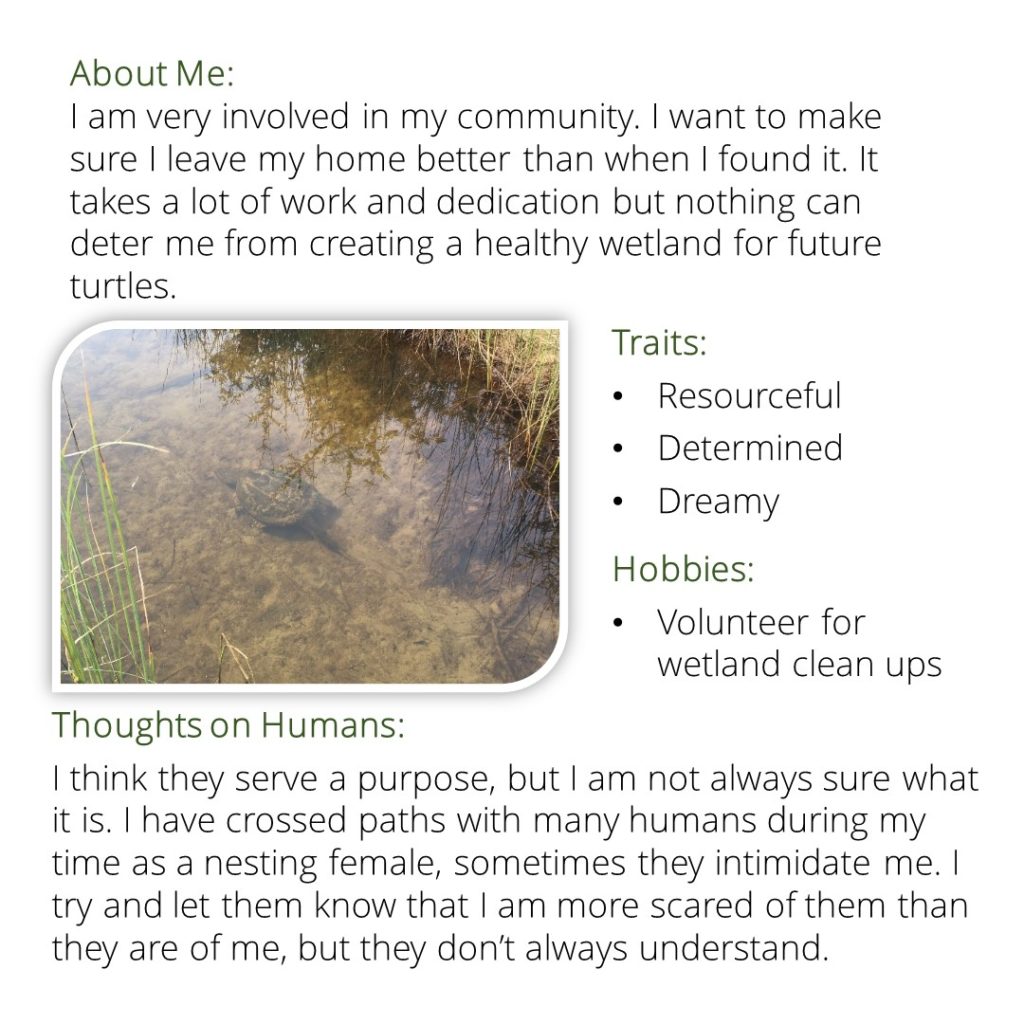
Carl
There is a certain smell that comes along with researching turtles that one comes to accept, almost enjoy, and sometimes miss once the season is over. However, occasionally you get a cheeky Painted Turtle that reminds you that the smell is not so sweet. This little stinker was lovingly named Carl. Carl knew no boundaries as he dropped a stink bomb on Tianna, GBB’s Conservation Biologist, who was joining in the field that day and was taking his measurements. And yes, I do mean Carl impolitely pooped on her. His smug attitude is matched by his tough appearance including the shell spikes (near his head) and sharp Tomidont (turtle tooth-like points on the beak). Using these features for combat, mating, or prey capture, this Painted Turtle is likely a bruiser in the wetland.
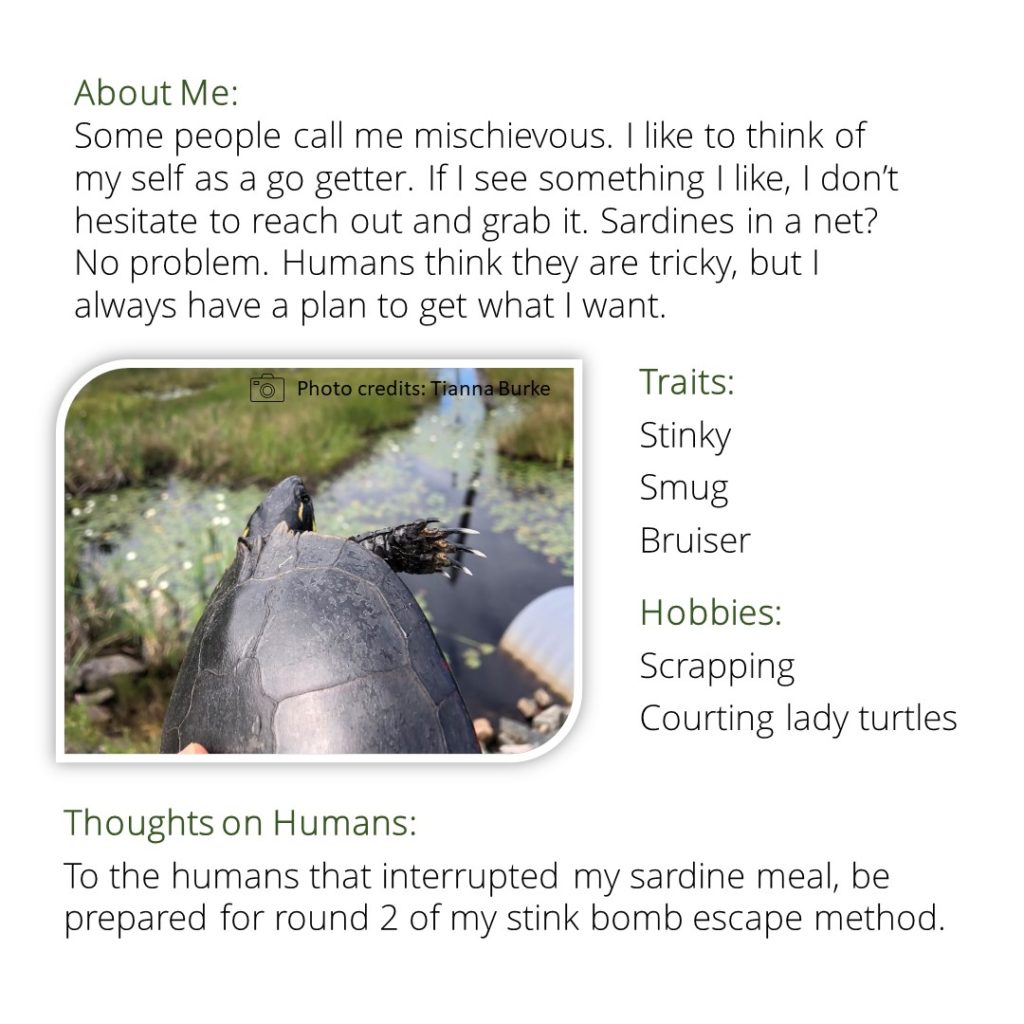
Though I have only highlighted a few turtles here, every turtle captured was unique and dear to our hearts. Stay tuned to see who we capture in 2022!
Learn more about the Maamwi Anjiakiziwin initiative and how you can get involved!